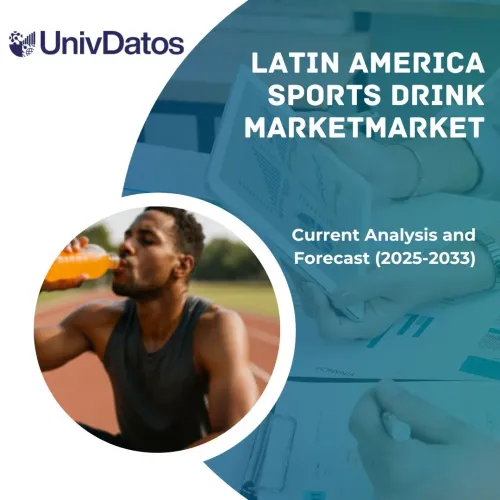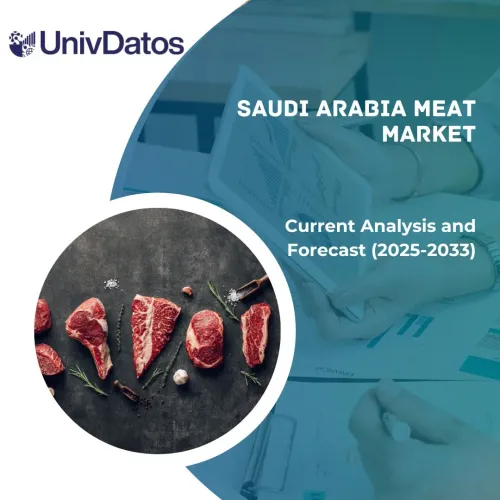- Home
- About Us
- Industry
- Services
- Reading
- Contact Us
MENA Nutraceuticals Market: Current Analysis and Forecast (2022-2030)
Emphasis on Product Type (Dietary Supplements, Functional Foods, and Functional Beverages); Application (Hype Weight Management & Satiety, Aesthetics, Sports Nutrition, and Others); Distribution Channel (Hypermarkets/Supermarkets, Convenience Stores, Online Retail, and Others); Country
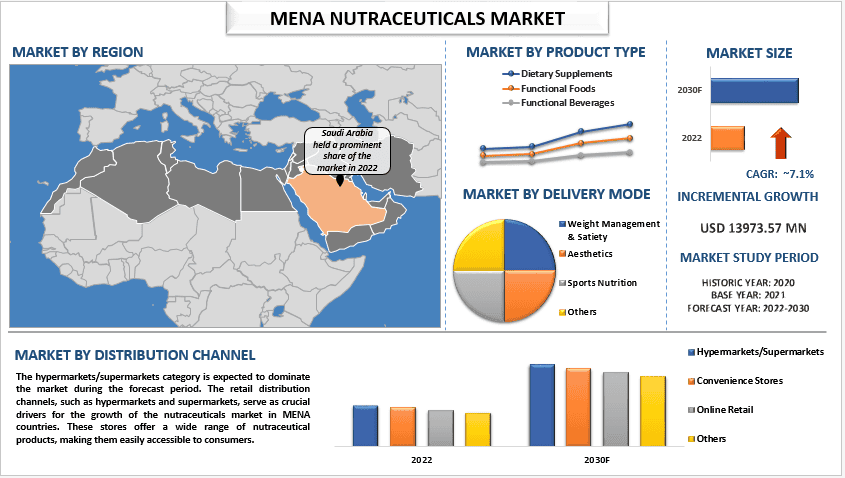
The MENA Nutraceuticals Market was valued at USD 13,973.57 million in the year 2022 and is expected to grow at a strong CAGR of around 7.1% during the forecast period (2023-2030). The MENA nutraceuticals market is poised for substantial growth, driven by several key factors. Defined as products derived from food sources with extra health benefits, nutraceuticals are gaining traction in the region due to the growing aging population, increasing incidence of chronic diseases, and a shift towards more health-conscious consumer choices. The opportunities within this market are vast, with a surge in research and development of innovative nutraceutical products that cater to specific health needs. Investment in manufacturing facilities, distribution networks, and marketing campaigns is on the rise, reflecting the mounting interest from both regional and global players.
Furthermore, regulatory bodies in MENA countries are recognizing the importance of standardizing nutraceutical products, which will bolster consumer confidence and further stimulate market growth. As the MENA region’s healthcare landscape continues to evolve, the nutraceuticals market is primed to be at the forefront of the wellness and preventative health movement.
Some of the major players operating in the market include Pfizer Inc.; Bayer AG; Vitabiotics Ltd.; Nestlé; Danone; BASF SE; PepsiCo; General Mills Inc.; Nature’s Way; and Abbott Several M&As along with partnerships have been undertaken by these players to facilitate customers with hi-tech and innovative products/technologies.
Insights Presented in the Report
“Amongst product type, the functional foods category is expected to grow at the fastest CAGR during the forecast period.”
Based on Product type, the market is segmented into dietary supplements, functional foods, and functional beverages. Among them, the functional foods category is expected to grow at the fastest CAGR during the forecast period. There is a strong demand for functional foods that align with traditional dietary preferences and offer health benefits. For instance, functional foods containing ingredients like dates, honey, and various Middle Eastern spices are gaining popularity due to their potential health-enhancing properties. With the increasing incidence of lifestyle-related diseases such as diabetes and heart conditions, consumers in MENA are seeking convenient ways to incorporate health-promoting ingredients into their diets. This trend has led to a surge in the consumption of functional foods, contributing significantly to the growth of the nutraceutical market in the region.
“Amongst distribution channel, the online retail category is expected to grow at the fastest CAGR during the forecast period.”
Based on the distribution channel, the market is segmented into hypermarkets/supermarkets, convenience stores, online retail, and others. Among them, the online retail category is expected to grow at the fastest CAGR during the forecast period. Online platforms offer a diverse selection of dietary supplements, vitamins, and functional foods, allowing consumers to research and purchase products that cater to their specific health needs. Furthermore, the convenience of doorstep delivery and the ability to compare prices and products from different brands online have led to increased consumer interest in nutraceuticals. The online retail channel also caters to consumers in both urban and rural areas, making it a significant catalyst for the expansion of the nutraceutical market in MENA countries.
“UAE Region is Expected to Grow at the Fastest CAGR During the Forecast Period”
In the UAE, the nutraceuticals market represents a thriving segment of the healthcare industry. Nutraceuticals encompass products like dietary supplements, functional foods, and herbal extracts, which are consumed for their potential health benefits. The market in the UAE is primarily driven by the country’s affluence and a growing focus on health and wellness. As a hub for tourism and business, the UAE has a diverse population with varying dietary preferences, creating a demand for a wide range of nutraceutical products. Opportunities in this market include introducing innovative and culturally tailored nutraceuticals, emphasizing quality and safety to meet stringent regulatory standards, and capitalizing on the UAE’s status as a global trading center to expand market reach. Additionally, aligning with the government’s vision for a healthier nation presents opportunities for nutraceutical companies to make a significant impact in the UAE.
MENA Nutraceuticals Market Report Coverage
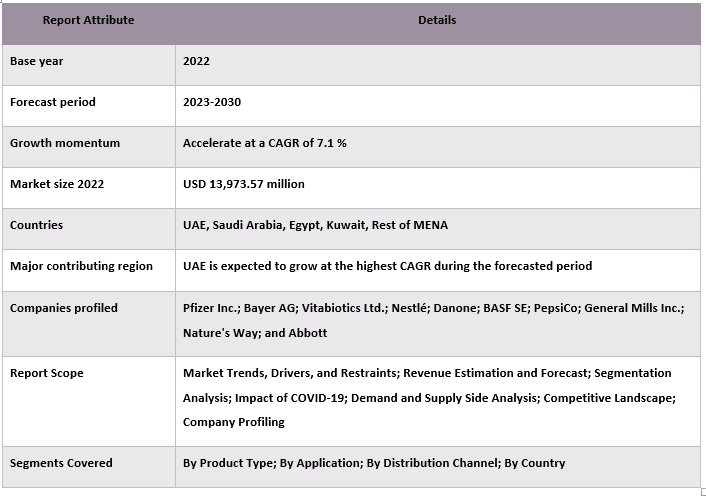
Reasons to buy this report:
- The study includes market sizing and forecasting analysis validated by authenticated key industry experts.
- The report presents a quick review of overall industry performance at one glance.
- The report covers an in-depth analysis of prominent industry peers with a primary focus on key business financials, product portfolios, expansion strategies, and recent developments.
- Detailed examination of drivers, restraints, key trends, and opportunities prevailing in the industry.
- The study comprehensively covers the market across different segments.
- Deep dive regional level analysis of the industry.
Customization Options:
The MENA Nutraceuticals Market can further be customized as per the requirement or any other market segment. Besides this, UMI understands that you may have your own business needs, hence feel free to contact us to get a report that completely suits your requirements.
Table of Content
Research Methodology for the MENA Nutraceuticals Market Analysis (2023-2030)
Analyzing the historical market, estimating the current market, and forecasting the future market of the MENA Nutraceuticals Market were the three major steps undertaken to create and analyze the adoption of nutraceuticals in major countries in MENA. Exhaustive secondary research was conducted to collect the historical market numbers and estimate the current market size. Secondly, to validate these insights, numerous findings and assumptions were taken into consideration. Moreover, exhaustive primary interviews were also conducted, with industry experts across the value chain of the MENA Nutraceuticals Market. Post assumption and validation of market numbers through primary interviews, we employed a top-down/bottom-up approach to forecasting the complete market size. Thereafter, market breakdown and data triangulation methods were adopted to estimate and analyze the market size of segments and sub-segments of the industry pertains to. Detailed methodology is explained below:
Analysis of Historical Market Size
Step 1: In-Depth Study of Secondary Sources:
Detail secondary study was conducted to obtain the historical market size of the MENA Nutraceuticals Market through company internal sources such as annual reports & and financial statements, performance presentations, press releases, etc., and external sources including journals, news & and articles, government publications, competitor publications, sector reports, third-party database, and other credible publications.
Step 2: Market Segmentation:
After obtaining the historical market size of the MENA Nutraceuticals Market, we conducted a detailed secondary analysis to gather historical market insights and share for different segments & and sub-segments for major regions. Major segments are included in the report as product type, application, and distribution channel. Further country-level analyses were conducted to evaluate the overall adoption of testing models in that region.
*Step 3: Factor Analysis:
After acquiring the historical market size of different segments and sub-segments, we conducted a detailed factor analysis to estimate the current market size of the MENA Nutraceuticals Market. Further, we conducted factor analysis using dependent and independent variables such as product type, application, and distribution channel of the MENA Nutraceuticals Market. A thorough analysis was conducted for demand and supply-side scenarios considering top partnerships, mergers and acquisitions, business expansion, and product launches in the MENA Nutraceuticals Market sector across the globe.
Current Market Size Estimate & Forecast
Current Market Sizing: Based on actionable insights from the above 3 steps, we arrived at the current market size, key players in the MENA Nutraceuticals Market, and market shares of the segments. All the required percentage shares split, and market breakdowns were determined using the above-mentioned secondary approach and were verified through primary interviews.
Estimation & Forecasting: For market estimation and forecast, weights were assigned to different factors including drivers & trends, restraints, and opportunities available for the stakeholders. After analyzing these factors, relevant forecasting techniques i.e., the top-down/bottom-up approach were applied to arrive at the market forecast for 2030 for different segments and sub-segments across the major markets globally. The research methodology adopted to estimate the market size encompasses:
- The industry’s market size, in terms of revenue (USD) and the adoption rate of the MENA Nutraceuticals Market across the major markets domestically
- All percentage shares, splits, and breakdowns of market segments and sub-segments
- Key players in the MENA Nutraceuticals Market in terms of products offered. Also, the growth strategies adopted by these players to compete in the fast-growing market.
Market Size and Share Validation
Primary Research: In-depth interviews were conducted with the Key Opinion Leaders (KOLs) including Top Level Executives (CXO/VPs, Sales Head, Marketing Head, Operational Head, Regional Head, Country Head, etc.) across major regions. Primary research findings were then summarized, and statistical analysis was performed to prove the stated hypothesis. Inputs from primary research were consolidated with secondary findings, hence turning information into actionable insights.
Split of Primary Participants in Different Regions
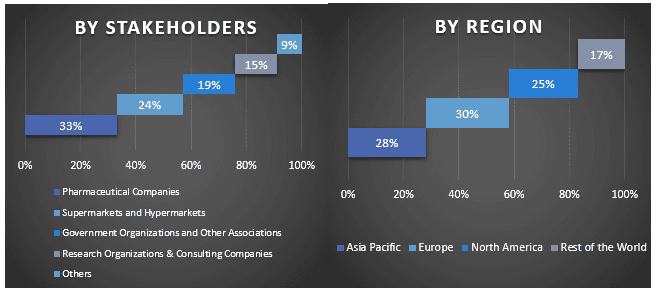
Market Engineering
The data triangulation technique was employed to complete the overall market estimation and to arrive at precise statistical numbers for each segment and sub-segment of the MENA Nutraceuticals Market. data was split into several segments & sub-segments post studying various parameters and trends in the areas of the product type, application, and distribution channel in the MENA Nutraceuticals Market.
The main objective of the MENA Nutraceuticals Market Study
The current & future market trends of the MENA Nutraceuticals Market were pinpointed in the study. Investors can gain strategic insights to base their discretion for investments on the qualitative and quantitative analysis performed in the study. Current and future market trends determined the overall attractiveness of the market at a regional level, providing a platform for the industrial participant to exploit the untapped market to benefit from a first-mover advantage. Other quantitative goals of the studies include:
- Analyze the current and forecast market size of the MENA Nutraceuticals Market in terms of value (USD). Also, analyze the current and forecast market size of different segments and sub-segments.
- Segments in the study include areas of the product type, application, and distribution channel.
- Define and analysis of the regulatory framework for the surgical instrument
- Analyze the value chain involved with the presence of various intermediaries, along with analyzing customer and competitor behaviors of the industry.
- Analyze the current and forecast market size of the MENA Nutraceuticals Market for the major region.
- Major countries of regions studied in the report include Asia Pacific, Europe, North America, and the Rest of the World
- Company profiles of the MENA Nutraceuticals Market and the growth strategies adopted by the market players to sustain in the fast-growing market.
- Deep dive regional level analysis of the industry
Related Reports
Customers who bought this item also bought


